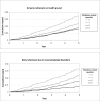Employee control over working times and risk of cause-specific disability pension: the Finnish Public Sector Study
- PMID: 19914911
- PMCID: PMC3226939
- DOI: 10.1136/oem.2008.045096
Employee control over working times and risk of cause-specific disability pension: the Finnish Public Sector Study
Abstract
Objective: To examine the association between worktime control and subsequent disability pension among employees.
Methods: Two scores of worktime control (self-assessed and co-worker assessed) were obtained from a survey in 2000-2001 (score range 1-5) among 30 700 public sector employees (78% women) aged 18-64 years. Information on cause-specific disability pension during follow-up was collected from national registers.
Results: During a mean follow-up of 4.4 years, 1178 employees were granted disability pensions (incidence per 1000 person-years: 9.2 in women and 8.7 in men). The most common causes of a disability pension were musculoskeletal disorders (43% of all pensions), mental disorders (25%), tumours (8%) and diseases of the circulatory system (6%) and nervous system (6%). A one unit increase in self-assessed and co-worker assessed worktime control score was associated with a 41-48% decrease in risk of disabling musculoskeletal disorders in men and a 33-35% decrease in women. This association was robust to adjustment for 17 baseline covariates (in men and women combined, adjusted HR 0.76, 95% CI 0.67 to 0.87 and 0.64, 95% CI 0.51 to 0.79 per one unit increase in self-assessed and co-worker assessed worktime control, respectively). Self-assessed, but not co-worker assessed, worktime control was also associated with risk of disability retirement due to mental disorders in women. Disability pensions from other disease categories were not related to worktime control.
Conclusions: In these public sector employees, high worktime control was associated with reduced risk of early retirement caused by musculoskeletal disorders independent of baseline characteristics.
Figures
Similar articles
-
Job strain as a predictor of disability pension: the Finnish Public Sector Study.J Epidemiol Community Health. 2009 Jan;63(1):24-30. doi: 10.1136/jech.2007.071407. Epub 2008 Sep 3. J Epidemiol Community Health. 2009. PMID: 18768568
-
Depression and early retirement: prospective population based study in middle aged men.J Epidemiol Community Health. 2005 Jan;59(1):70-4. doi: 10.1136/jech.2003.010702. J Epidemiol Community Health. 2005. PMID: 15598730 Free PMC article.
-
Job strain and the risk of disability pension due to musculoskeletal disorders, depression or coronary heart disease: a prospective cohort study of 69,842 employees.Occup Environ Med. 2012 Aug;69(8):574-81. doi: 10.1136/oemed-2011-100411. Epub 2012 May 9. Occup Environ Med. 2012. PMID: 22573793
-
Occupational burnout as a predictor of disability pension: a population-based cohort study.Occup Environ Med. 2009 May;66(5):284-90; discussion 282-3. doi: 10.1136/oem.2008.038935. Epub 2008 Nov 18. Occup Environ Med. 2009. PMID: 19017706
-
Physical workload and risk of early retirement: prospective population-based study among middle-aged men.J Occup Environ Med. 2002 Oct;44(10):930-9. doi: 10.1097/00043764-200210000-00012. J Occup Environ Med. 2002. PMID: 12391772
Cited by
-
Effects of requested, forced and denied shift schedule change on work ability and health of nurses in Europe -results from the European NEXT-Study.BMC Public Health. 2013 Dec 5;13:1137. doi: 10.1186/1471-2458-13-1137. BMC Public Health. 2013. PMID: 24308567 Free PMC article.
-
Precarious work increases depression-based disability among male employees.Eur J Public Health. 2021 Dec 1;31(6):1223-1230. doi: 10.1093/eurpub/ckab119. Eur J Public Health. 2021. PMID: 34254115 Free PMC article.
-
Working conditions as predictors of retirement intentions and exit from paid employment: a 10-year follow-up of the English Longitudinal Study of Ageing.Eur J Ageing. 2016;13(1):39-48. doi: 10.1007/s10433-015-0357-9. Epub 2015 Nov 27. Eur J Ageing. 2016. PMID: 27034644 Free PMC article.
-
Short-term sick leave and future risk of sickness absence and unemployment - the impact of health status.BMC Public Health. 2012 Oct 10;12:861. doi: 10.1186/1471-2458-12-861. BMC Public Health. 2012. PMID: 23050983 Free PMC article.
-
Risk of disability pension in first and second generation immigrants: the role of age and region of birth in a prospective population-based study from Sweden.BMC Public Health. 2017 Dec 4;17(1):931. doi: 10.1186/s12889-017-4944-x. BMC Public Health. 2017. PMID: 29202827 Free PMC article.
References
-
- Allebeck P, Mastekaasa A. Chapter 5. Risk factors for sick leave - general studies. Scand J Public Health. 2004;32(Suppl 63):49–108. - PubMed
-
- Krokstad S, Johnsen R, Westin S. Social determinants of disability pension: a 10-year follow-up of 62 000 people in a Norwegian county population. Int J Epidemiol. 2002;31:1183–91. - PubMed
-
- Knauth P. Innovative worktime arrangements. Scand J Work Environ Health. 1998;24(suppl):13–17. - PubMed
Publication types
MeSH terms
Grants and funding
LinkOut - more resources
Full Text Sources
Medical

